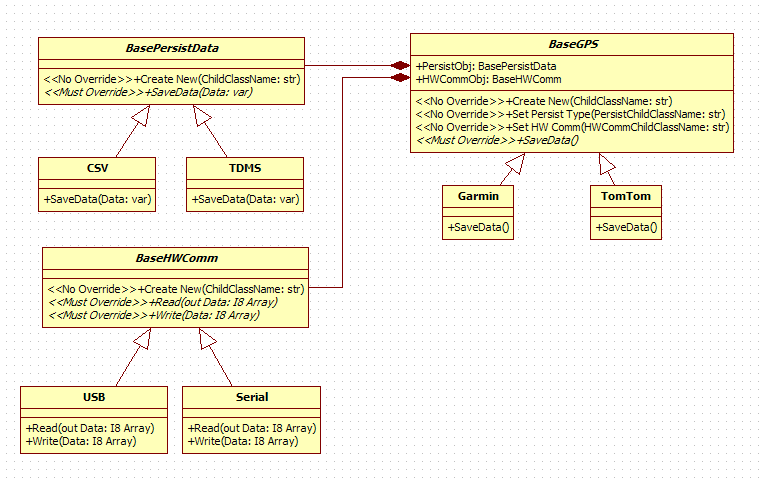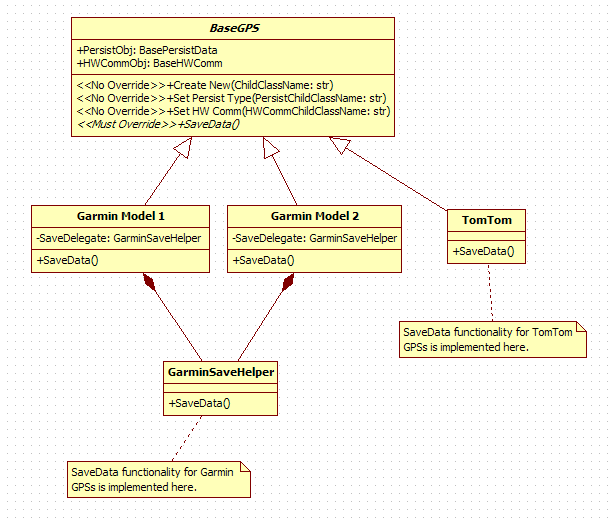Leaderboard
Popular Content
Showing content with the highest reputation on 12/20/2017 in all areas
-
Ton, While the ideas of OO programming are pretty straightforward, actually designing a good OO architecture is quite difficult. Newcomers (and I include myself in this group) overuse inheritance, underuse abstract classes, and tend to develop a class hierarchy that is very difficult to modify and maintain. The kind of stuff you're trying to do is why I think getting interfaces in Labview is so important to LVOOP. (And why I keep talking about them.) The hierarchy you posted isn't going to work very well. The exact design depends a lot on the requirements of the application you are building--especially with respect to what changes might be required in the future. Here's a diagram I put together that I believe will give you more flexibility. It's just a starting point; modify it to fit your requirements. [Quick UML explanation for those unfamiliar with it] Each block represents one class with the top section containing the class name in bold. The middle section is the private data contained in the class. The bottom section lists the class methods (member VIs.) Italicised names indicate an abstract class (BaseGPS) or function (SaveData). Non-italicised names indicate a concrete implementation. The arrow with the hollow triangle indicates inheritance. (Garmin inherits from BaseGPS.) The line with the solid diamond indicates composition, meaning one class contains another class as private data. (The BaseGPS class has a BaseHWComm class as a member of its private data.) [/uML explanation] Notice the linking between the three different class sets is always through the abstract classes. This helps maintain modularity and flexibility. For example, if you need to implement wireless communication in a future product, you simply derive a new child class ("802.11g") from BaseHWComm, modify BaseHWComm:CreateNew.vi to accomodate the new class, and you're good to go. (Mostly... it depends on exactly how you use the HWComm functionality in BaseGPS.) Also note that your coding is primarily done using abstract class methods, not the concrete class methods. For example, in your application all your GPS functionality is built using VIs from BaseGPS. In your Garmin and TomTom classes you use VIs from BasePersistData and BaseHWComm, not the child classes. There are drawbacks to this design: If you want to expose any of the methods from BasePersistData or BaseHWComm you essentially have to wrap a BaseGPS method around them. This is extra coding that in a perfect world wouldn't be necessary. If your class has a lot of classes as private data it can mean a lot extra VIs that clutter up the BaseGPS API. It can also potentially lead to naming confusion if more than one class uses the same name for member VIs. As it turns out, just this last weekend I prototyped a framework for LV8.6 that implements interfaces in a way that more closely matches other languages. I also have a LV2009 design on paper that comes even closer... I think it will work but I haven't implemented it yet. I'm planning on writing them up and posting it soon. I don't think this makes sense from an OO point of view. USB and Serial are used by GPS, they are not subsets of GPS. I found this link a while back and the articles really solidified my understanding of what my OO designs were missing. Especially the Dependency Inversion Principle and the Walking Through a UML Design case study. In that document the delegate pattern says, "This pattern applies best when you have a dynamic VI inherited from some ancestor and two descendent classes want to override that dynamic VI with exactly the same implementation. Delegation helps you avoid writing the implementation twice, once for each of the two classes." This is the way I see the pattern described in the article. Delegating functionality is very common in OO architectures, but the Delegate Pattern described in the article addresses the specific problem of avoiding having to duplicate code in similar child classes. That seems to me to be a different problem than the one Ton described. I recognize that the diagram I put together could be considered a slightly more complicated version of the Delgate Pattern, but it's a mighty big leap from point A to point B for us noobs. (If you ever get around to revising that article I suggest putting in some simple UML diagrams to help explain the patterns.)1 point



